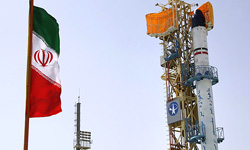Iran to Send 6 New Home-Made Satellites into Orbit Next Year


Head of Iran’s Space Agency Ahmad Fazeli announced on Tuesday that the country will send 6 new home-made satellites, mostly made by Iranian universities, to the space in the next Iranian year (starting on March 21).
“Based on the foreseen timeline, Fajr, Sharif Sat, Tolou, Zafar, and A-Test will be sent to the space by the end of the next year,” Fazeli told reporters in Tehran on Monday.
He said that Mesbah is also among the satellites which will be sent to orbit next year.
Fazeli also announced that Iran will send a home-made satellite named Nahid to the space by the end of the current Iranian year.
Earlier this month, Iran unveiled a prototype model of Nahid telecommunications satellite.
The prototype model was unveiled during a ceremony attended by Iranian President Mahmoud Ahmadinejad, Defense Minister Ahmad Vahidi and Fazeli at an exhibition of Iran’s latest space achievements and technologies here in the capital.
Also earlier today, President of Iran’s Amirkabir University Alireza Rahayee announced that “A-Test and Nahid are ready to be launched and sent into the orbit”.
“The engineering model of A-Test satellite has been unveiled and its launch prototype is also ready and we hope that it will be sent into the orbit soon,” he added, addressing the 12th conference of Iran’s aerospace association in Tehran on Tuesday.
Rahayee also said that studies on satellite Nahid have been carried out in cooperation with the Iranian Space Industry (ISA), adding that the satellite will be ready for launch next year.
In November, Rahayee had announced that researchers at Amirkabir University of Technology had accomplished part of the studies on Satellite Nahid, and said it would be launched into the space with the backing of the Iranian Space Agency (ISA).
Rahayee noted that the industrial phases of the project had accomplished and researchers were now working on the launch phase.







